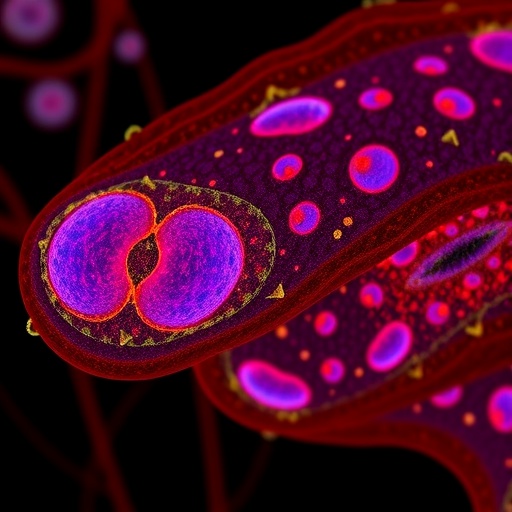In the intricate ecosystem of the human gut, the harmonious dialogue between epithelial and mesenchymal cells maintains intestinal homeostasis and orchestrates regenerative processes. Recent groundbreaking research has unveiled a novel layer of complexity in this cross-communication, identifying epithelial GREMLIN1 as a critical disruptor that remodels the intestinal stromal environment to induce an aberrant, Wnt-dependent stem cell niche. These findings, published in Nature Communications, promise to reshape our understanding of stem cell biology and tissue dynamics in gastrointestinal physiology and pathology.
The intestinal epithelium is a highly regenerative tissue wherein stem cells reside within precisely regulated niches. These niches provide signals essential for stem cell maintenance and differentiation, driving the continuous renewal of the gut lining. Central to this niche regulation is the paracrine interplay between epithelial cells and adjacent mesenchymal stromal populations. Through finely tuned signaling networks, these compartments collaborate to sustain the delicate balance between proliferation and differentiation necessary for intestinal function.
At the heart of this newly described mechanism is GREMLIN1, a secreted glycoprotein classically recognized as a Bone Morphogenetic Protein (BMP) antagonist. Expressed by epithelial cells, GREMLIN1 has now been implicated in a maladaptive alteration of the stromal milieu. By inhibiting BMP signaling locally, epithelial GREMLIN1 shifts the stromal microenvironment toward a state that promotes Wnt pathway activation—a pivotal axis for stem cell identity and expansion.
This Wnt-dependent ectopic stem cell niche generated through epithelial GREMLIN1-mediated stromal remodeling contrasts starkly with canonical intestinal stem cell niches. Unlike the tightly compartmentalized crypt base where endogenous stem cells thrive, the ectopic niche emerges outside conventional boundaries, potentially leading to deregulated proliferation and aberrant tissue architecture. Such mislocalization may underlie the pathogenesis of hyperproliferative disorders or contribute to tumorigenesis.
The study employed a sophisticated combination of genetic mouse models, single-cell transcriptomics, and advanced imaging techniques to deconvolute the cellular players and molecular circuits involved. Conditional overexpression of GREMLIN1 specifically in intestinal epithelial compartments was sufficient to alter stromal gene expression profiles, characterized by upregulation of Wnt ligands and downstream targets, concomitant with suppression of BMP-responsive elements in neighboring mesenchymal cells.
Further dissection revealed that this epithelial-to-stromal signaling axis entails profound changes in the extracellular matrix (ECM) composition and stiffness—factors increasingly recognized for their role in modulating stem cell behavior. The remodeled ECM seemingly facilitates the expansion of a Wnt-responsive stem cell population, which co-opts the aberrant niche for maintenance and self-renewal. This paracrine feedback loop underscores the plasticity within intestinal compartments and hints at a broader principle of epithelial factors instructing stromal dynamics.
Importantly, these findings resonate beyond basic biology and may bear clinical significance. The ectopic niche formation induced by GREMLIN1 may reflect early events in the cellular rewiring that precedes intestinal metaplasia or neoplastic transformation. Moreover, therapeutic targeting of the GREMLIN1-Wnt axis might offer novel intervention strategies to halt or reverse aberrant stem cell activation in diseases such as inflammatory bowel disease (IBD) or colorectal cancer.
Remarkably, this research elucidates how epithelial cells are not merely passive recipients of stromal cues but active architects of their own microenvironment through secreted factors like GREMLIN1. This paradigm shift exemplifies the growing appreciation for bidirectional communication that governs tissue homeostasis and highlights potential vulnerabilities exploitable in disease contexts.
Mechanistically, the inhibition of BMP signaling by GREMLIN1 appears to relieve suppression on Wnt ligand secretion by stromal fibroblasts. BMP signaling has been traditionally viewed as a negative regulator of stemness, promoting differentiation and limiting proliferation. The interplay between GREMLIN1-mediated BMP antagonism and stromal Wnt activation creates an environment favorable for stem cell proliferation outside physiological confines.
The implications of this research extend to the broader field of stem cell niche biology where the spatial and molecular characteristics of niche components are paramount. Understanding how niche plasticity arises and can be co-opted during disease states could aid in the design of biomimetic scaffolds for tissue engineering or inform regenerative medicine strategies.
From a technical standpoint, the study’s strength lies in its multi-dimensional approach. By integrating lineage tracing, spatial transcriptomics, and biomechanical assays, it provides an unprecedented resolution of the cellular microenvironment and the molecular conversations that sustain it. These methodologies serve as benchmarks for future explorations into epithelial-stromal interactions across organ systems.
Intriguingly, the formation of a Wnt-dependent ectopic niche echoes phenomena observed in other tissues where aberrant niche signaling leads to pathological conditions. For instance, similar disruptions in epithelial-mesenchymal crosstalk have been implicated in fibrotic diseases and cancer metastasis, underscoring the universality of these mechanisms.
Looking forward, this discovery opens several exciting avenues for research. Key questions include the reversibility of GREMLIN1-induced niche remodeling, the identity of upstream regulators controlling epithelial GREMLIN1 expression, and the precise cellular thresholds at which niche disruption translates to disease. Additionally, exploring the role of immune components within this remodeled milieu may elucidate further complexity.
In conclusion, the identification of epithelial GREMLIN1 as a pivotal modulator of intestinal epithelial-mesenchymal crosstalk heralds a new chapter in our understanding of stem cell niche biology. By orchestrating a shift toward a Wnt-dependent ectopic niche through stromal remodeling, GREMLIN1 challenges traditional views of compartmentalized niche regulation and spotlights the dynamic reciprocity underlying tissue homeostasis and pathology. As scientific efforts build on these insights, novel diagnostic and therapeutic strategies targeting niche dynamics may emerge, revolutionizing care for gastrointestinal diseases.
Subject of Research: Epithelial GREMLIN1’s role in disrupting intestinal epithelial-mesenchymal interactions to create a Wnt-dependent ectopic stem cell niche via stromal remodeling.
Article Title: Epithelial GREMLIN1 disrupts intestinal epithelial-mesenchymal crosstalk to induce a wnt-dependent ectopic stem cell niche through stromal remodelling.
Article References: Mulholland, E.J., Belnoue-Davis, H.L., Valbuena, G.N. et al. Epithelial GREMLIN1 disrupts intestinal epithelial-mesenchymal crosstalk to induce a wnt-dependent ectopic stem cell niche through stromal remodelling. Nat Commun 16, 5167 (2025). https://doi.org/10.1038/s41467-025-60364-6
Image Credits: AI Generated




